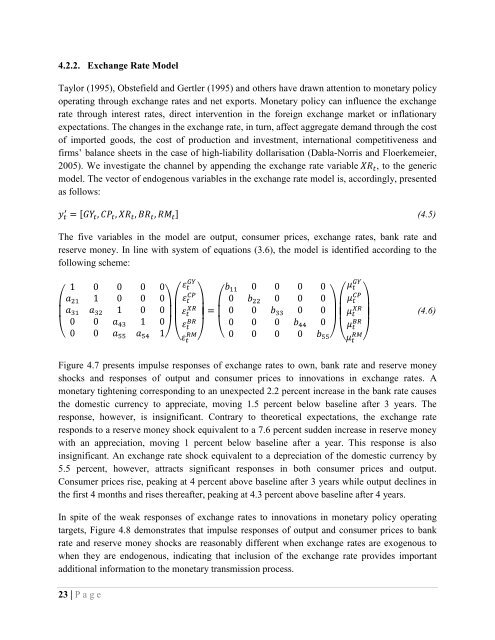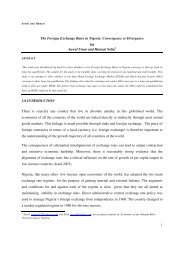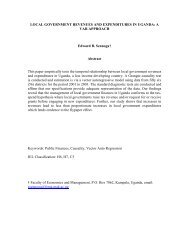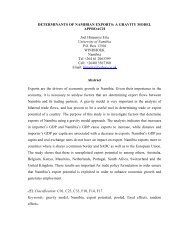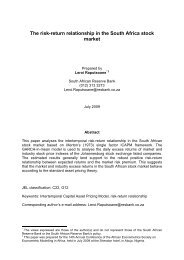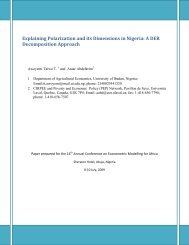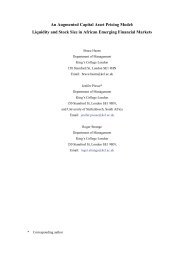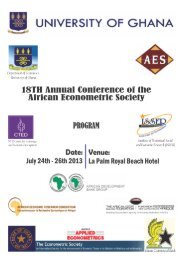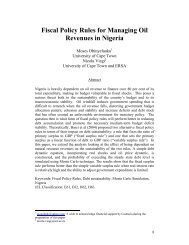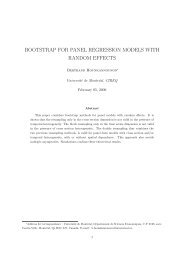Dynamic Effects of Monetary Policy Shocks in Malawi* - African ...
Dynamic Effects of Monetary Policy Shocks in Malawi* - African ...
Dynamic Effects of Monetary Policy Shocks in Malawi* - African ...
You also want an ePaper? Increase the reach of your titles
YUMPU automatically turns print PDFs into web optimized ePapers that Google loves.
4.2.2. Exchange Rate ModelTaylor (1995), Obstefield and Gertler (1995) and others have drawn attention to monetary policyoperat<strong>in</strong>g through exchange rates and net exports. <strong>Monetary</strong> policy can <strong>in</strong>fluence the exchangerate through <strong>in</strong>terest rates, direct <strong>in</strong>tervention <strong>in</strong> the foreign exchange market or <strong>in</strong>flationaryexpectations. The changes <strong>in</strong> the exchange rate, <strong>in</strong> turn, affect aggregate demand through the cost<strong>of</strong> imported goods, the cost <strong>of</strong> production and <strong>in</strong>vestment, <strong>in</strong>ternational competitiveness andfirms‟ balance sheets <strong>in</strong> the case <strong>of</strong> high-liability dollarisation (Dabla-Norris and Floerkemeier,2005). We <strong>in</strong>vestigate the channel by append<strong>in</strong>g the exchange rate variable , to the genericmodel. The vector <strong>of</strong> endogenous variables <strong>in</strong> the exchange rate model is, accord<strong>in</strong>gly, presentedas follows:The five variables <strong>in</strong> the model are output, consumer prices, exchange rates, bank rate andreserve money. In l<strong>in</strong>e with system <strong>of</strong> equations (3.6), the model is identified accord<strong>in</strong>g to thefollow<strong>in</strong>g scheme:(4.5)(4.6)Figure 4.7 presents impulse responses <strong>of</strong> exchange rates to own, bank rate and reserve moneyshocks and responses <strong>of</strong> output and consumer prices to <strong>in</strong>novations <strong>in</strong> exchange rates. Amonetary tighten<strong>in</strong>g correspond<strong>in</strong>g to an unexpected 2.2 percent <strong>in</strong>crease <strong>in</strong> the bank rate causesthe domestic currency to appreciate, mov<strong>in</strong>g 1.5 percent below basel<strong>in</strong>e after 3 years. Theresponse, however, is <strong>in</strong>significant. Contrary to theoretical expectations, the exchange rateresponds to a reserve money shock equivalent to a 7.6 percent sudden <strong>in</strong>crease <strong>in</strong> reserve moneywith an appreciation, mov<strong>in</strong>g 1 percent below basel<strong>in</strong>e after a year. This response is also<strong>in</strong>significant. An exchange rate shock equivalent to a depreciation <strong>of</strong> the domestic currency by5.5 percent, however, attracts significant responses <strong>in</strong> both consumer prices and output.Consumer prices rise, peak<strong>in</strong>g at 4 percent above basel<strong>in</strong>e after 3 years while output decl<strong>in</strong>es <strong>in</strong>the first 4 months and rises thereafter, peak<strong>in</strong>g at 4.3 percent above basel<strong>in</strong>e after 4 years.In spite <strong>of</strong> the weak responses <strong>of</strong> exchange rates to <strong>in</strong>novations <strong>in</strong> monetary policy operat<strong>in</strong>gtargets, Figure 4.8 demonstrates that impulse responses <strong>of</strong> output and consumer prices to bankrate and reserve money shocks are reasonably different when exchange rates are exogenous towhen they are endogenous, <strong>in</strong>dicat<strong>in</strong>g that <strong>in</strong>clusion <strong>of</strong> the exchange rate provides importantadditional <strong>in</strong>formation to the monetary transmission process.23 | P a g e


